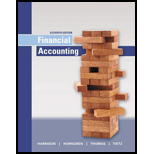
To identify: The appropriate debit/credit entry for the issuance of common stock from the given options.
Answer to Problem 1QC
c. credit to common stock for $30,000
Explanation of Solution
Common stock: These are the ordinary shares that a corporation issues to the investors in order to raise funds. In return, the investors receive a share of profit from the profits earned by the corporation in the form of dividend.
Par value: It refers to the value of a stock that is stated by the corporation’s charter. It is also known as face value of a stock.
| Date | Account Titles and Explanation | Debit ($) | Credit ($) |
| Cash (1) | 330,000 | ||
| Common Stock (2) | 30,000 | ||
| Paid-in Capital in Excess of Par value –Common stock (3) | 300,000 | ||
| (To record issuance stock for cash) |
Table (1)
Working note:
Compute the amount of cash received.
Compute common stock value.
Compute paid-in capital in excess of par-common value.
- Cash is an asset account. The amount has increased because cash is received by issuing shares; therefore, debit Cash account with $330,000.
- Common Stock is a
stockholders’ equity account and the amount has increased due to issuance of common stock. Therefore, credit Common Stock account with $30,000. - Paid–in Capital in Excess of Par–Common is a stockholders’ equity account and the amount has increased due to increase in capital. Therefore, credit Paid–in Capital in Excess of Par–Common account with $330,000.
Option a:
“Option a” is not correct, because issuance of stock debits cash account but not common stock account.
Option b:
“Option b” is not correct, because credit amount of paid-in capital in excess of par must be $300,000 but not $330,000.
Option c:
“Option c” is correct, issuance of common stock credits common stock account for $30,000.
Option d:
“Option d” is not correct, because option a is not correct, even if option b is correct.
Want to see more full solutions like this?
Chapter 10 Solutions
Financial Accounting (11th Edition)
- Bansai, age 66, retires and receives a $1,450 per month annuity from his employer's qualified pension plan. Bansai made $87,600 of after-tax contributions to the plan before retirement. Under the simplified method, Bansai's number of anticipated payments is 240. What is the amount includible in income in the first year of withdrawals assuming 12 monthly payments? A. $10,560 B. $12,540 C. $17,400 D. $8,220arrow_forwardWhat is the cost of goods sold?arrow_forwardCan you help me find the accurate solution to this financial accounting problem using valid principles?arrow_forward

 AccountingAccountingISBN:9781337272094Author:WARREN, Carl S., Reeve, James M., Duchac, Jonathan E.Publisher:Cengage Learning,
AccountingAccountingISBN:9781337272094Author:WARREN, Carl S., Reeve, James M., Duchac, Jonathan E.Publisher:Cengage Learning, Accounting Information SystemsAccountingISBN:9781337619202Author:Hall, James A.Publisher:Cengage Learning,
Accounting Information SystemsAccountingISBN:9781337619202Author:Hall, James A.Publisher:Cengage Learning, Horngren's Cost Accounting: A Managerial Emphasis...AccountingISBN:9780134475585Author:Srikant M. Datar, Madhav V. RajanPublisher:PEARSON
Horngren's Cost Accounting: A Managerial Emphasis...AccountingISBN:9780134475585Author:Srikant M. Datar, Madhav V. RajanPublisher:PEARSON Intermediate AccountingAccountingISBN:9781259722660Author:J. David Spiceland, Mark W. Nelson, Wayne M ThomasPublisher:McGraw-Hill Education
Intermediate AccountingAccountingISBN:9781259722660Author:J. David Spiceland, Mark W. Nelson, Wayne M ThomasPublisher:McGraw-Hill Education Financial and Managerial AccountingAccountingISBN:9781259726705Author:John J Wild, Ken W. Shaw, Barbara Chiappetta Fundamental Accounting PrinciplesPublisher:McGraw-Hill Education
Financial and Managerial AccountingAccountingISBN:9781259726705Author:John J Wild, Ken W. Shaw, Barbara Chiappetta Fundamental Accounting PrinciplesPublisher:McGraw-Hill Education





